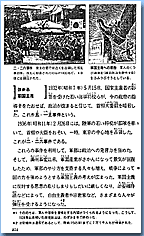|
On May 15, 1932 (Showa 7), a group
of naval officers influenced by nationalists assassinated the
prime minister since they believed they could change the politics
by throwing out current government leaders (1). This is called
the 5•15 incident.
On February 26, 1936 (Showa 11), a young
army officer leading a unit attacked the prime minister and
other ministers, temporarily occupying the center of Tokyo.
This is called the 2•26 incident.
Using these incidents, the military strengthened the influence
of the government. Then, after the Manchurian incident
the munitions industry and economy recovered, so people supporting
the military increased and militaristic ideas that would strengthen
the country through war, spread.
Violations for thoughts against militarism became severe, and
according to the Maintenance of the Public Order Act, liberalists,
religious leaders, and various people were oppressed (2).
1 After that, either a soldier or bureaucrat would become prime
minister of the cabinet. And so, party politics, which went
on since 1924, was over in only 8 years.
2 Until the defeat (1945), 75,000 people were arrested in violation
of the Maintenance of the Public Order Act.
|


